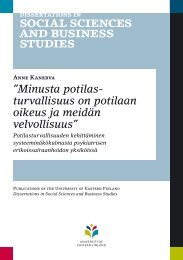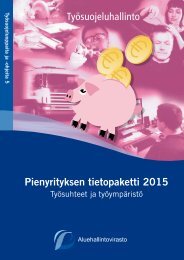urn_isbn_978-952-61-1770-6
urn_isbn_978-952-61-1770-6
urn_isbn_978-952-61-1770-6
- No tags were found...
Create successful ePaper yourself
Turn your PDF publications into a flip-book with our unique Google optimized e-Paper software.
Golder is the leading case in respect of ‘object and purpose’ interpretation. 73After framing the ‘object and purpose’ interpretation, the ECtHR took a step forwardin Tyrer by outlining ‘living instrument’ interpretation. 74 It stated: ‘…theConvention is a living instrument which, as the Commission rightly stressed,must be interpreted in the light of present-day conditions...’. 75 It has gone evenfurther than this by recognising rights that the drafters had not clearly intendedto grant (e.g. right not to join a trade union). 76In the 1960s the Commission characterised autonomous concepts by statingthat they: ‘…cannot be construed as a mere reference to the domestic law of theHigh Contracting Party concerned but relate to an autonomous concept whichmust be interpreted independently, even though the general principles of theHigh Contracting Parties must necessarily be taken into consideration in anysuch interpretation.’ 77 This passage implies a certain tension with the concepts ofthe Convention and the meaning of these concepts in domestic law.In Engel, the ECtHR had to decide whether military penalties which werestrictly disciplinary, as opposed to criminal, offences could fall within the scopeof Article 6 (which insists on the right to a fair and public hearing ‘in determinationof his civil rights and obligations or any criminal charge against him...’). 78 Inthis case the ECtHR developed the theory of ‘autonomous concepts’, maintainingthat the meaning ascribed to the terms ‘criminal charge’ and ‘disciplinary charge’in the law of the respondent state did not reflect the meaning given to those sameterms under the Convention. Since Engel, the ECtHR has developed the theoryof autonomous concepts to the point where it is now a significant doctrine. 79 Ithas held that autonomous concepts are those whose ‘definition in national lawhas only relative value and constitutes no more than a starting point’. 80 It hasalso characterised as autonomous a significant number of concepts that figure inthe Convention. These include ‘criminal charge’, 81 ‘civil rights and obligations’, 82‘possessions’, 83 ‘association’, 84 ‘victim’, 85 ‘civil servant’ 86 and ‘lawful detention’. 87The ECtHR had referred on many occasions to the principle of effectivenessand the principle of consequences prior to adopting a rigid formulation of the73Golder v. The United Kingdom (1975), para. 34.74Tyrer v. The United Kingdom (1<strong>978</strong>).75Ibid., para. 31.76Young, James and Webster v. The United Kingdom (1981), paras. 51-52; Letsas 2009, at 65–67.77Twenty-One Detained Persons v. Germany (1968), para. 4.78Engel and Others v. The Netherlands (1976), para. 82.79Letsas 2009, at 42.80Chassagnou and Others v. France (1999), para. 100.81Engel and Others v. The Netherlands (1976); Campbell and Fell v. The United Kingdom (1984).82König v. Germany (1<strong>978</strong>); Sporrong and Lönnroth v. Sweden (1982).83Gasus Dosier- und Fordertechnik GmbH v. The Netherlands (1995); Iatridis v. Greece (1999); Former Kingof Greece and Others v. Greece (2000).84Chassagnou and Others v. France (1999).85Asselbourg and 78 others and Greenpeace Association-Luxembourg v. Luxembourg (1999).86Pellegrin v. France (1999).87Eriksen v. Norway (1997); Witold Litwa v. Poland (2000).27




